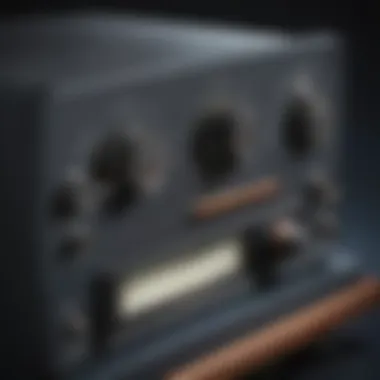Mastering the Art of Decibel Level Testing for Sound Measurement and Control


Science Fun Facts
When delving into the fascinating world of sound measurement, understanding decibel levels is key. Did you know that the decibel scale is logarithmic, not linear? This means that a small change in decibels corresponds to a significant change in sound intensity. For instance, an increase of 10 d B represents a sound ten times more intense! Understanding this logarithmic scale is crucial for accurate sound assessment and control.
Discover the Wonders of Science
In the realm of sound engineering, decibel levels play a crucial role. By exploring various scientific concepts related to sound waves and intensity, we can grasp the significance of decibel measurements. Educational videos and animations can further enhance our understanding of how sound levels are measured and why decibels are essential in assessing noise pollution and maintaining equipment efficiency.
Science Quiz Time
Are you ready for a brain-teasing challenge related to sound measurement? Here's a thought-provoking question: What is the threshold of pain in terms of decibel levels? Test your knowledge with an interactive quiz on decibel measurements and sound intensity. Multiple-choice questions will help reinforce your understanding of decibels and their real-life applications in different environments.
Science Experiment Showcase
In our hands-on exploration of decibel levels, let's conduct a fun and engaging experiment. With step-by-step instructions and a materials list, we can create our sound meter to measure decibels in various settings. Safety tips and precautions are crucial when working with sound equipment, ensuring we conduct our experiments responsibly and accurately.
Introduction
Decibel levels play a crucial role in sound measurement and control, making them an essential aspect of sound analysis. Understanding decibel levels is vital for a range of applications, from assessing noise levels in various environments to ensuring audio equipment functions optimally. This article serves as a comprehensive guide to testing decibel levels, offering insights into the intricate process involved and the significance of accurate decibel measurements.
Importance of Decibel Levels
Understanding sound intensity
Sound intensity, a key component of decibel levels, provides valuable information about the strength of sound waves. Understanding sound intensity allows professionals to gauge the power of sound and its impact on the surrounding environment. By delving into sound intensity, individuals can assess the loudness of noise accurately, aiding in noise control measures and regulatory compliance.
Impact of excessive noise exposure
Excessive noise exposure can have detrimental effects on both human health and the environment. High decibel levels can lead to hearing damage, stress, and other health issues. By exploring the impact of excessive noise exposure, individuals can grasp the importance of maintaining appropriate sound levels to safeguard well-being and enhance quality of life.
Purpose of Decibel Testing
Ensuring compliance with noise regulations
Ensuring compliance with noise regulations is a critical aspect of decibel testing. By conducting decibel tests, organizations can ascertain whether their noise levels adhere to legal standards. This process is essential for industries where noise exposure is a concern, helping them avoid regulatory penalties and potential harm to individuals.
Calibrating audio equipment
Calibrating audio equipment is another key purpose of decibel testing. By measuring sound levels accurately, professionals can adjust audio equipment to deliver optimal performance. Calibration ensures that audio outputs are precise and consistent, enhancing overall sound quality and user experience.


Basic Overview of Sound
Explanation of sound waves
Understanding sound waves is fundamental to comprehending the behavior of sound. Sound waves travel through various mediums, with factors such as frequency and amplitude influencing their properties. Exploring sound waves sheds light on how sound propagates and interacts with its surroundings, serving as a basis for advanced sound analysis.
Frequency and amplitude in sound
Frequency and amplitude are essential characteristics of sound that impact its pitch and volume. Frequency determines the pitch of sound, with higher frequencies corresponding to higher pitches. Amplitude, on the other hand, dictates the loudness of sound, influencing its intensity and reach. By examining frequency and amplitude in sound, individuals can gain a deeper understanding of sound properties and how they relate to decibel levels.
Methods for Decibel Testing
In this section, we delve into the crucial aspect of methods for decibel testing. Understanding the methodologies behind decibel testing is fundamental in ensuring accurate sound measurements and control. By exploring specific elements such as calibration techniques, measurement tools, and environmental factors, we can attain a comprehensive grasp of testing decibel levels. This information is not only significant for professionals in the sound industry but also for anyone looking to comprehend the nuances of sound analysis thoroughly.
Using Sound Level Meters
Calibrating the meter
Calibrating the meter plays a pivotal role in sound level measurements. This process involves adjusting the sensitivity of the sound level meter to ensure that it provides precise readings. The calibration of the meter contributes significantly to the accuracy and reliability of the decibel measurements. Professionals often rely on calibrated meters to adhere to industry standards and regulations. The unique feature of meter calibration lies in its ability to provide consistent and verifiable results, making it a popular choice for various sound analysis procedures.
Taking accurate readings
Another critical aspect of decibel testing is the ability to take accurate readings. This process entails capturing sound data effectively and translating it into meaningful decibel values. The key characteristic of taking accurate readings lies in the meticulous attention to detail and proper positioning of the sound level meter. By ensuring that readings are precise and consistent, professionals can make informed decisions regarding sound levels and potential interventions. While this process may have limitations regarding environmental factors, the advantages of accurate readings include reliable data for analysis and decision-making.
Decibel Measurement Techniques
A-weighting vs. C-weighting
When considering decibel measurement techniques, the choice between A-weighting and C-weighting is essential. A-weighting focuses on replicating the human ear's response to different frequencies, making it suitable for assessing noise levels in everyday environments. On the other hand, C-weighting provides a flat frequency response, offering a more accurate representation of overall sound pressure levels. The unique feature of these weighting filters lies in their adaptability to different sound scenarios, each with its advantages and disadvantages in specific testing situations.
Peak vs. average measurements
Differentiating between peak and average measurements is crucial in capturing sound dynamics effectively. Peak measurements identify the maximum sound levels reached during a specific period, offering insights into sudden spikes in noise. Conversely, average measurements provide a more comprehensive overview of steady-state noise levels over time. The key characteristic of these measurement techniques lies in their ability to offer distinct perspectives on sound intensity, aiding in comprehensive sound analysis strategies. Understanding when to utilize peak or average measurements is essential for accurate decibel assessments.
Environmental Considerations
Effect of ambient noise
The effect of ambient noise on decibel testing cannot be understated. Ambient noise levels can interfere with accurate sound measurements, influencing the overall assessment of decibel levels. Professionals need to consider ambient noise sources in their testing environments to mitigate potential inaccuracies in readings. The unique feature of addressing ambient noise lies in the ability to isolate sound signals from background noise, enhancing the precision of decibel measurements.


Testing in controlled vs. open environments
Choosing between controlled and open environments for decibel testing is a critical consideration. Controlled environments provide stable conditions for sound measurements, allowing for accurate assessments without external interference. In contrast, testing in open environments reflects real-world scenarios, offering insights into sound propagation and exposure in natural settings. The key characteristic of testing in different environments lies in the balance between controlled conditions for precise measurements and realistic settings for practical sound analysis applications.
Applications of Decibel Testing (300-400 words)
Applications of Decibel Testing stand as a pivotal element within this comprehensive article. The significance of understanding decibel levels resonates across various domains, playing a crucial role in sound measurement and control. By exploring industrial noise monitoring, audio equipment calibration, and environmental noise assessment, the versatile applications of decibel testing become evident. These applications are not just limited to the scientific community but extend to industries, communities, and even wildlife habitats. Each facet of decibel testing serves a unique purpose in ensuring safety, efficiency, and quality in sound-related activities.
Industrial Noise Monitoring (250-300 words)
Safety regulations compliance within industrial noise monitoring is a cornerstone of ensuring a safe working environment. By adhering to stipulated noise regulations and standards, organizations can protect their workforce from potential hearing damage and maintain productivity levels. Implementing effective safety regulations compliance measures involves utilizing sound level meters, conducting regular assessments and implementing noise control measures. Despite the challenges in compliance, the benefits of safeguarding employees' health and enhancing overall productivity outweigh the complexities associated with this aspect of industrial noise monitoring.
Worker protection measures further augment the significance of industrial noise monitoring by focusing on individual well-being. The use of personal protective equipment, noise-canceling technologies, and creating soundproof environments are essential components of worker protection measures. By prioritizing employee safety, organizations demonstrate a commitment to maintaining a healthy and harmonious workplace environment. Although implementing these measures may incur initial costs, the long-term advantages of reduced health risks and enhanced employee morale make worker protection measures a valuable investment within industrial noise monitoring.
Audio Equipment Calibration (250-300 words)
Ensuring balanced audio output in the process of audio equipment calibration is integral to achieving optimal sound quality and performance. By calibrating various audio components such as amplifiers, speakers, and microphones, professionals can fine-tune audio signals for accurate reproduction. The meticulous calibration process involves adjusting frequency response, volume levels, and audio settings to achieve a harmonious audio output. The benefits of balanced audio output include minimizing distortion, enhancing clarity, and improving overall audio fidelity.
Optimizing sound quality further refines the audio calibration process by focusing on enhancing the auditory experience. Professionals utilize advanced audio tools and software to fine-tune audio signals, eliminate background noise, and enhance audio dynamics. By optimizing sound quality, individuals can enjoy immersive audio experiences across various platforms, from music production and live performances to home entertainment systems. While optimizing sound quality requires technical expertise and experimentation, the rewards of achieving premium audio output justify the investment in this critical aspect of audio equipment calibration.
Environmental Noise Assessment (250-300 words)
The impact of environmental noise on wildlife habitats underscores the importance of environmental noise assessment in preserving ecological balance. By monitoring sound levels in natural settings, environmentalists can assess the influence of human activities on wildlife behavior and habitats. The unique features of environmental noise assessment include conducting sound surveys, analyzing acoustic data, and implementing noise mitigation strategies to protect wildlife populations. While there are challenges in mitigating human-induced noise pollution, the benefits of safeguarding natural habitats and promoting biodiversity make environmental noise assessment a crucial endeavor in sound monitoring and ecological conservation.
Community noise mapping complements environmental noise assessment by visualizing sound data and identifying noise hotspots in urban areas. By creating detailed noise maps, urban planners and policymakers can implement noise control measures, design quieter infrastructure, and enhance residents' quality of life. The advantages of community noise mapping include promoting public awareness of noise pollution, facilitating urban planning decisions, and fostering healthier living environments. Despite the limitations in completely eradicating noise pollution, the proactive approach of community noise mapping offers tangible benefits in mitigating noise disturbances and promoting sustainable urban development.
Challenges and Considerations
When delving into the realm of decibel testing, one must carefully navigate the array of challenges and considerations that come with this intricate process. By shedding light on the potential stumbling blocks and critical factors to consider, individuals can ensure the accuracy and reliability of their decibel readings. These challenges encompass a wide range of aspects, from environmental variables to technical limitations, all of which impact the outcome of decibel testing.
Measurement Accuracy
Factors affecting precision
In the realm of decibel testing, the precision of measurements plays a pivotal role in ensuring the authenticity of results. Factors affecting precision delve into the intricacies of equipment calibration, environmental conditions, and user proficiency. The calibration of sound level meters and their adherence to industry standards significantly contribute to the accuracy of decibel measurements. Understanding how variations in environmental factors can skew results is crucial for mitigating errors and obtaining reliable data.
Error margins in decibel readings
Another essential aspect of measurement accuracy lies in comprehending the potential error margins in decibel readings. These margins highlight the tolerance levels within which readings may fluctuate, emphasizing the importance of interpreting results within a specific range of uncertainty. By acknowledging and accounting for these margins, practitioners can enhance the credibility of their findings and make informed decisions based on the nuances of decibel testing.


Interpreting Decibel Values
Subjective perception of loudness
Interpreting decibel values goes beyond the numerical aspect, delving into the subjective perception of loudness. Understanding how individuals subjectively experience different decibel levels is crucial for contextualizing the impact of sound on human perception. By integrating subjective elements into decibel analysis, one can capture the nuanced relationship between sound intensity and its psychological effects on individuals.
Comparing different d
B levels
Comparing various decibel levels offers a comprehensive view of sound intensity across different contexts. By juxtaposing d B levels from diverse sources, individuals can discern patterns, identify outliers, and draw meaningful comparisons. This comparative analysis not only enhances data interpretation but also paves the way for informed decision-making in noise management and sound control strategies.
Legal Implications
Decibel limits in various industries
Legal implications of decibel testing extend to the establishment of industry-specific limits regulating sound levels. These limits aim to ensure occupational safety, environmental protection, and public health by defining acceptable thresholds for noise exposure. Adhering to these limits is paramount for businesses, organizations, and individuals operating within regulated industries to avoid legal repercussions and uphold sound governance practices.
Enforcement of noise ordinances
Enforcement of noise ordinances underscores the governance and enforcement mechanisms in place to maintain compliance with sound regulations. By enforcing noise ordinances, authorities uphold community standards, protect public health, and mitigate noise pollution. Understanding the enforcement protocols and consequences of violating noise ordinances is essential for fostering a harmonious coexistence within varied environmental settings.
Conclusion
Testing decibel levels is a critical aspect of sound analysis and control. Understanding decibel levels is essential for maintaining a safe and regulated sound environment. Through accurate decibel testing, industries can ensure compliance with noise regulations and individuals can calibrate their audio equipment effectively. The precision in decibel measurements plays a vital role in various fields, from industrial noise monitoring to environmental noise assessment, highlighting the significance of decibel testing in sound management. Decibel values carry legal implications, and interpreting them correctly is crucial for enforcing noise ordinances and ensuring a healthy auditory environment.
Summary of Decibel Testing
Essentiality in sound analysis
Decibel testing serves as a cornerstone in sound analysis, providing a quantitative measure of sound intensity. The essentiality of decibel testing lies in its ability to offer precise and standardized readings, making it a reliable choice for analyzing sound across different scenarios. Its unique feature lies in its objectivity, removing subjectivity from sound evaluation and allowing for accurate comparisons and assessments. While essential for sound engineers and professionals, decibel testing also aids amateurs in understanding sound properties effectively.
Versatile applications in diverse fields
Decibel testing finds multifaceted applications across diverse fields, showcasing its adaptability and usefulness. Its versatility enables its deployment in industrial settings for ensuring worker safety and compliance with safety regulations. Additionally, decibel testing plays a crucial role in calibrating audio equipment, enhancing audio output quality, and optimizing sound performance. Its ability to analyze environmental noise and impact on wildlife habitats underlines its importance in promoting eco-conscious sound practices across communities.
Final Thoughts
Continuous learning for sound professionals
Continuous learning is a fundamental aspect of mastering decibel testing for sound professionals. Engaging in ongoing education enhances professionals' understanding of evolving sound technologies, measurement techniques, and regulatory standards. It empowers them to stay abreast of industry advancements and refine their decibel testing skills, ensuring accurate sound analysis and control. The commitment to continuous learning is imperative for sound professionals to deliver precise and informed assessments consistently.
Future advancements in decibel measurement
Future advancements in decibel measurement are poised to revolutionize sound analysis and testing methodologies. The integration of cutting-edge technologies like AI and machine learning promises to enhance the accuracy and efficiency of decibel measurements. These advancements will streamline the decibel testing process, making it more accessible and user-friendly. Embracing future innovations in decibel measurement will pave the way for more intricate sound analyses, improved noise assessments, and advanced applications across various industries.







